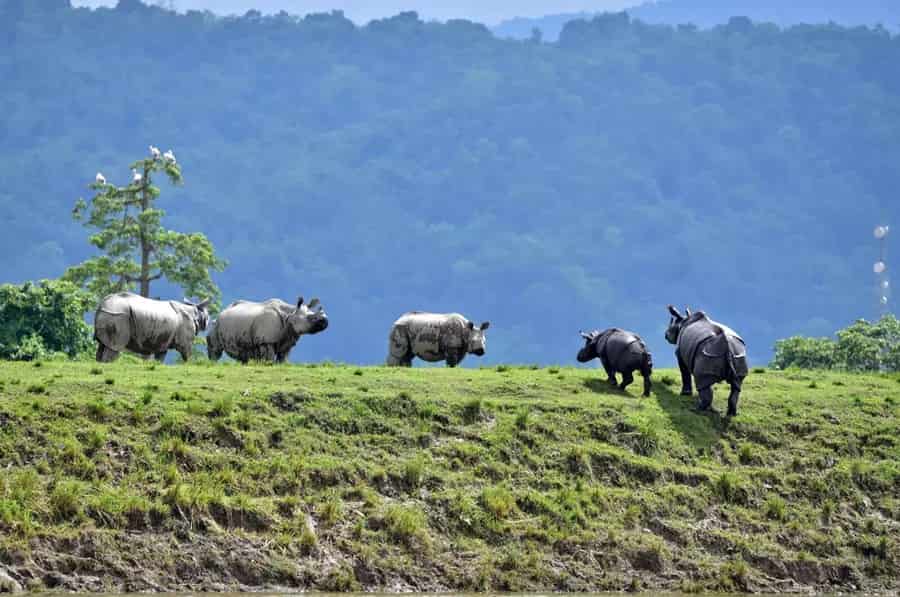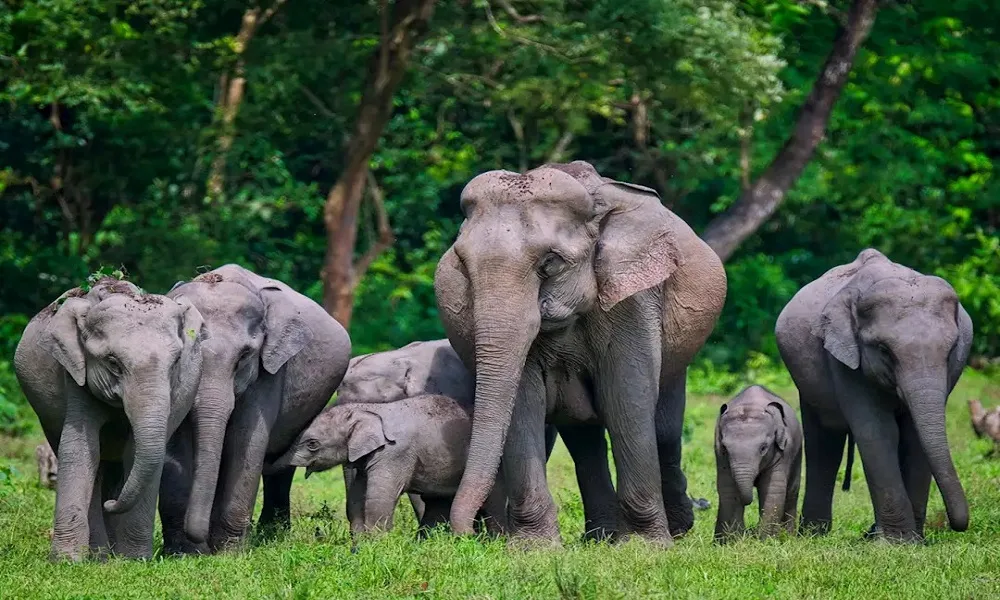Last Updated on 22/04/2025
Assam is home to several renowned wildlife sanctuaries and national parks, which offer a blend of natural beauty and rich biodiversity. These sanctuaries are excellent for wildlife enthusiasts, nature lovers, and photographers. Below are some of the most famous ones:
Kaziranga National Park
- Location: Located along the Brahmaputra River, Assam.
- Famous for: The one-horned rhino and abundant wildlife.
- UNESCO Status: A UNESCO World Heritage Site.
- Wildlife: Home to diverse fauna, including elephants, tigers, and birds.
- Accessibility: Accessible by air (Jorhat), rail, and road from Guwahati.
- Best Time to Visit: November to March (Closed mid-April to mid-October).

Kaziranga National Park lies along the south bank of the Brahmaputra River. The park’s setting is breathtaking, with the national highway leading to it flanked by tea plantations, and the misty Mikir Hills serving as a picturesque backdrop.
The famed one-horned rhino, for which this World Heritage Site is renowned, offers abundant sightings. In fact, during early morning safaris on elephants, you’ll likely see many of these rhinos calmly grazing, barely paying attention to your presence. However, when there is a baby rhino nearby, the magnificent animal may turn aggressive. Despite its heavy build, the ‘armoured’ rhino can run surprisingly fast.
Covering 430 square kilometers, Kaziranga is one of India’s best conservation success stories, home to over 2,000 rhinos, despite the toll poaching has taken over the years. In 1966, the park had only 366 rhinos. Even as early as 1908, Kaziranga was declared a reserve forest with a ban on poaching, thanks to the efforts of Lady Curzon, wife of the then British Viceroy. In 1974, it was officially designated as a national park.
Kaziranga’s pride is its thriving population of one-horned rhinos, but it is also a biodiversity hotspot. The park’s dense grasslands, beels (wetlands), and tropical evergreen forests support a variety of wildlife, including elephants, Indian bison, swamp deer, hog deer, sloth bears, tigers, leopard cats, jungle cats, hoolock gibbons, wild boars, pythons, and monitor lizards. It is also a birdwatcher’s paradise, home to a wide range of species, and is recognized as an ‘important bird area’ by Bird Life International.
The park is easily accessible by air (via Jorhat), rail, and road from Guwahati or Jorhat. In addition to the forest lodge, there are several private resorts and guesthouses around the area. Jeeps are available for safaris, but nothing beats the excitement of an elephant ride, guided by experienced Forest Department mahouts. The park is closed from mid-April to mid-October.
Manas National Park
- Location: Located at the foothills of Bhutan, Assam.
- UNESCO Status: A UNESCO World Heritage Site, Project Tiger Reserve, and Elephant Reserve.
- Famous for: Rare species like the golden langur, hispid hare, and red panda.
- Wildlife: Offers a serene, tranquil experience with boat rides on the Manas River.
- Birdlife: Rich birdlife, including giant hornbills.
- Best Time to Visit: November to April.

Manas National Park is also located in Assam, at the foothills of Bhutan, and spans 2,840 square kilometers. It is a UNESCO World Heritage Site, a Project Tiger Reserve, an Elephant Reserve, and a Biosphere Reserve.
The main tourist area, Mathanguri, is situated along the northern banks of the Manas River, which flows from Bhutan. The park’s natural beauty is legendary, with the sparkling waters of the Manas reflecting the blue sky, orange-hued shrubs along the banks, and a tranquil silence that soothes the soul, especially in the evening. On lucky nights, visitors may witness herds of deer drinking from the river under the moonlight. To maintain the serenity of the park, the authorities restrict the use of bright electric lights and loud music.
Manas is known for its rare golden langur, the endangered hispid hare, and the elusive red panda. Rhinos were once abundant here, but political unrest took a toll on the population. Recently, two male rhinos were successfully translocated from Kaziranga to Manas. Bird lovers will find paradise in the park, where giant hornbills fly in flocks at dawn and dusk. Additionally, pheasants, jungle fowls, partridges, and various water birds are found here. A boat ride on the Manas River is an exhilarating experience. The best time to visit is from November to April.
The road to Manas, located 176 kilometers from Guwahati, offers scenic views of Assam’s rural beauty, with thatched huts, bamboo bridges, women in colorful handwoven clothes catching fish using Jakoi, and the majestic hills of the Himalayan foothills on the horizon. As poet and writer Hem Barua once described, this is truly the land of the “Red River, Blue Hills.”
Amazing Assam
One of the best ways to explore Assam is by taking a cruise along various sections of the Brahmaputra River. The cruise offers stunning views of the state’s wildlife and scenic landscapes.
Nameri National Park, located at the foothills of the eastern Himalayas, is home to tigers, black bears, elephants, and leopards, among others. Among the birds, the endangered white-winged wood duck is noteworthy.
The Jia Bhoroli River, which flows through the park, is famous for its golden Mahseer fish. An annual angling competition is held here every November. The nearby Eco Camp is a popular spot for camping.



 Call
Call WhatsApp
WhatsApp Enquiry
Enquiry